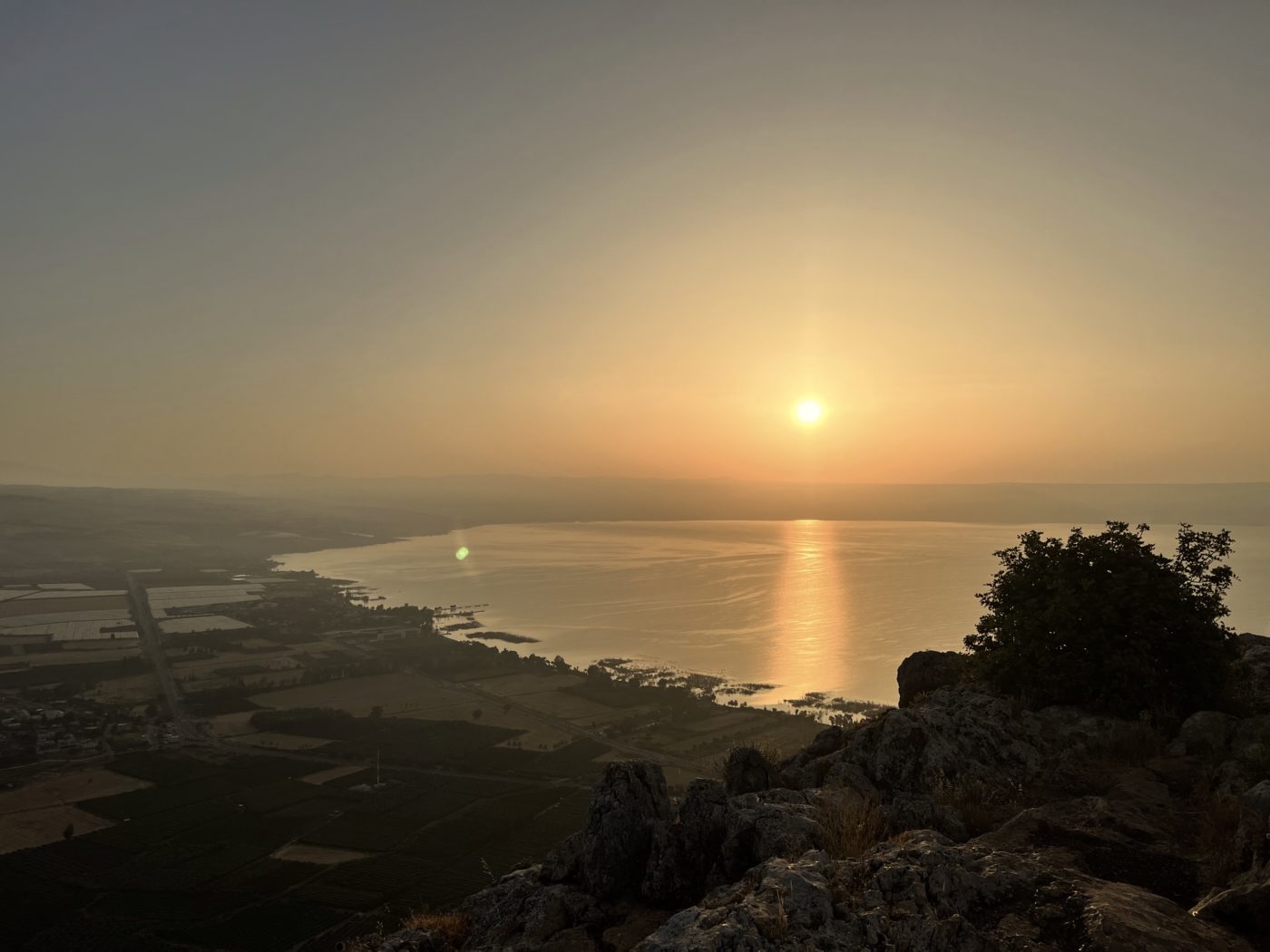
What I Learned from Walking in Jesus’ Footsteps
“Whoever says he abides in him ought to walk in the same way in which he walked.” (1 John 2:6, ESV)
Last May, I carved out nine days for an international trip. It was a 13,000+ miles round trip. With Covid measures still in place, I submitted to 3 tests in 72 hours in order to be cleared for the flights. With a wife and two kids, it wasn’t going to be easy to leave them for that many days. So, why do all this?
It was all so that I could spend a week walking.
Yes, walking.
As COO for RENEW.org, I have the honor and privilege to wake up each morning and try to help move the needle on making disciples through promoting good biblical theology. As a former international, corporate chef, I have done a lot of international travel, but this past May I was given the opportunity to visit a place I had never been before—the place where disciple making actually started. I was invited to join Mark Moore, teaching pastor of Christ’s Church of the Valley, as well as other national Restoration Movement leaders, on a walking tour of the Holy Land.
What I Learned about Jesus
In Israel, we walked somewhere around 125 miles, with 12 men, on trails very close to, if not exactly where, Jesus and his family and disciples would have walked.
Can I share with you a profound truth I learned from walking in Jesus’ footsteps?
It may not sound profound, but for me it really was: Walking mile after mile in Jesus’ footsteps taught me that Jesus did a ton of walking.
“Walking mile after mile in Jesus’ footsteps taught me that Jesus did a ton of walking.”
We were a multi-generational group with the youngest man in his 30’s to the oldest in his 70’s. We had all the very best backpacking and hiking gear the 21st century has to offer. None of us complained but we all experienced tired bodies, aching feet, blisters, sunburn, thirst, and the various other effects of the long arduous terrain we traveled by foot.
It never became clearer what “a day in the life” of young Jesus looked like than the 90+ minutes’ walk to Tzippori (the ancient city of Sepphoris) from his hometown of Nazareth. You see, Tzippori is the site of the most significant construction project happening in the days that Jesus was growing up. While he learned the carpenter trade from Joseph in his youth, they would, no doubt, travel to the growing Roman city because the work was plentiful for their specific trade.
Walking to Work
Research has revealed that the word we translate as “carpenter” would more accurately today be “builder” or “construction worker.” The “carpenters” of Jesus’ day would work with both wood and stone to build much of what would become the city of Tzippori. Jesus and Joseph would have found plentiful work here. Scholars have a very high level of confidence that Jesus and Joseph plied their trade there, and the first-century stones that they would have walked on are still there and free for you to step where they did.
How did a young Jesus and Joseph get to Tzippori from Nazareth? Like us, they got there on foot, carrying the tools and things they needed, perhaps lunch, and anything else the day’s work would call for. They would walk one way for over 90 minutes, with few shady places to stop and rest. They would walk in sandals without support for knees, or ankles, or the areas we gain support for with our undergarments. There wouldn’t have been well-fitting, moisture-wicking tech to avoid chafing. No bug spray, no sun cream, no sunglasses. This journey every day, both ways would build both physical and mental stamina and fortitude.
“This journey every day, both ways would build both physical and mental stamina and fortitude.”
They would then work. All day they would work and sweat and build and construct. Then they would walk back the way they came. The next day they likely got up and did it again.
You may have heard that Jesus would have been in great physical shape. That to endure the pain and abuse of the crucifixion and its accompanying abuse the way it is described, he must have had a noteworthy physical fortitude. I am here to tell you that I now understand how he got that way. It was 100 meters uphill going to work and 200 meters uphill on the way back, all while carrying the tools and implements they needed to do the heavy labor they were employed to do. Jesus and Joseph had tanned, toned bodies with calloused hands and feet from a tough, fitness-inducing lifestyle.
Walking with His Disciples
The experiences were rich as we engaged with the sites around us and had great conversations with other men desiring deep fellowship with other believers and spiritual communion with Jesus. We had some fun experiences too, as we climbed down the sheer cliff side of Mount Arbel (with the help of some fear-induced adrenaline boost), floated in the Dead Sea, and swam in the Sea of Galilea. This combined with the rich history of our faith all made it an amazing time.
Yet I couldn’t stop thinking about how much of Jesus’ life was spent walking. As an adult, Jesus spent much of three years walking from village to village with his disciples. Perhaps by default, we tend to picture Jesus walking along and teaching, as his twelve disciples jotted his teachings down in their notebooks. Yet walking the trails showed me how most of Jesus’ walking time would have been shared with just two or three people at a time.
“Walking the trails showed me how most of Jesus’ walking time would have been shared with just two or three people at a time.”
In a group of twelve men traveling together for over a week, I found myself talking to everyone eventually, but hardly ever all at once. In a group of twelve men walking across the Israeli landscape, through the old city of Jerusalem, up the Mount of Olives, traveling from Migdal to Capernaum and back again—you do it with only a couple of others at a time, sometimes just one other, sometimes alone.
It really gave me perspective on why we have unique Gospel vantage points and also on how Jesus had an “inner circle.” It became clear, for example, how a conversation about Judas could take place with him present but unaware of it, or how a convicting word to Peter could happen without all the disciples necessarily being made aware. Twelve men can have a lot of dynamic and different experiences from one another even when hanging out together all the time. I found that often one of us would say, “Hey did you notice this?” and find that no one else had.
Walking with Us
”Incarnation” is a word describing how Jesus, though God, put on flesh and became human (you can see the word for flesh in the root word “carn”). Walking in Jesus’ steps helped showed me just how incarnate he became.
He walked our pace. He got our earth’s dust on his skin. He spent hours upon hours walking with us and really getting to know us, in small groups, or one at a time.
Those daily 90-minute, one-way trips to the building site did more to Jesus than just make him physically strong. They made him surprisingly relatable and eternally empathetic toward us.
“He spent hours upon hours walking with us and really getting to know us.”
I’m glad I slowed down to a walking pace for those days because it gave me a glimpse of just how drastically Jesus slowed down to our human pace when he joined our human race.
“Since the children have flesh and blood, he too shared in their humanity.” (Heb. 2:14a, NIV)
Did you know Jesus still wants to walk with you, each and every day? His invitation is to join him, at a gentle, humble, and restful pace (Matt. 11:29), as he teaches us how to walk in his steps.
RENEW.org is a network of churches, church leaders, and everyday disciple makers, who try to trust and follow Jesus. If we can help you walk in Jesus’ steps, and begin, or continue your disciple making journey, please visit our website or join us at one of our upcoming events. We look forward to walking with you.









